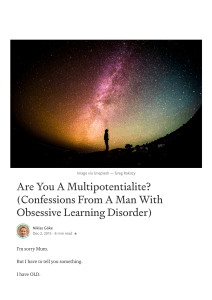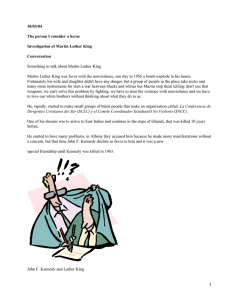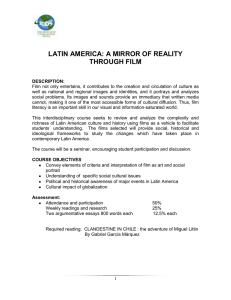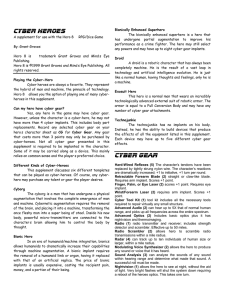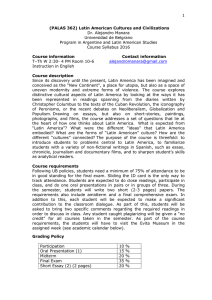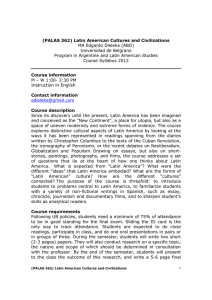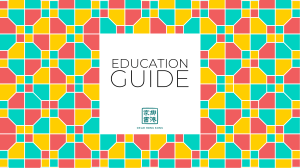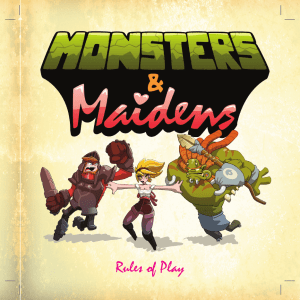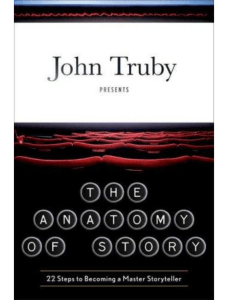Review/Reseña - NC State University
Anuncio
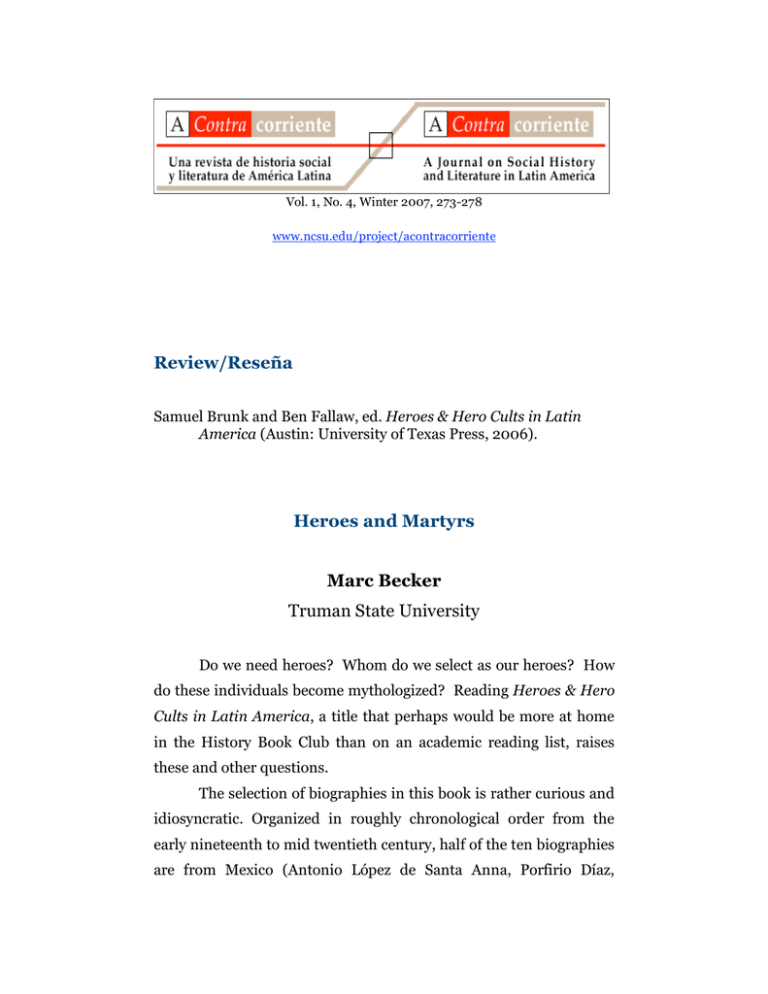
Vol. 1, No. 4, Winter 2007, 273-278 www.ncsu.edu/project/acontracorriente Review/Reseña Samuel Brunk and Ben Fallaw, ed. Heroes & Hero Cults in Latin America (Austin: University of Texas Press, 2006). Heroes and Martyrs Marc Becker Truman State University Do we need heroes? Whom do we select as our heroes? How do these individuals become mythologized? Reading Heroes & Hero Cults in Latin America, a title that perhaps would be more at home in the History Book Club than on an academic reading list, raises these and other questions. The selection of biographies in this book is rather curious and idiosyncratic. Organized in roughly chronological order from the early nineteenth to mid twentieth century, half of the ten biographies are from Mexico (Antonio López de Santa Anna, Porfirio Díaz, Becker 274 Emiliano Zapata, Felipe Carrillo Puerto, and Frida Kahlo). This imbalance is perhaps a function of having two Mexicanists as editors. Two are from Peru (Agustín Gamarra and Víctor Raúl Haya de la Torre), and one each from Venezuela (Simón Bolívar), Nicaragua (Augusto César Sandino), and Argentina (Evita Perón). Noticeable absent is anyone from Brazil (such as Getúlio Vargas), or from marginal sectors of Latin America. Only two of the biographies are of women (Kahlo and Perón). Perhaps this is only logical, as Linda Hall notes, because heroes are typically associated with male characteristics (229). While everyone would have their own favorites, it is doubtful that even among Latin Americans and Latin Americanists the majority of historical figures in this book would make it on to a short list of heroes. An interesting exercise in a Latin American history classroom is to ask students who they consider to be heroes. If they can name anyone, most likely it would be one of a trilogy pictured on the cover of this book (Zapata, Subcomandante Marcos, and Ernesto “Che” Guevara). Ironically, only Zapata is featured in the book and the others score only passing mention. It is easy to make a case for the presence of some of these Great Men in a book on heroes and hero cults. Bolívar is one of the best-known leaders to emerge out of Latin America, and even though he was a racist elitist (27) Venezuelans commonly place him at the top of their list of national heroes. Similarly, despite their shortcomings Nicaraguans, Argentines, and Mexicans greet Sandino, Perón, and Zapata in a similar fashion. A reader could rightfully question the inclusion of others in this volume. Even author Chuck Walker admits that conservative leader Gamarra, the subject of his chapter, “is not in the pantheon of heroic or mythical caudillos” (41). Unlike with Bolívar or Tupac Amaru, “modern political movements have little incentive to invoke his name” (54). Ben Fallaw identifies Carrillo Puerto, the subject of his chapter, as a “world-renowned Heroes and Martyrs 275 Socialist leader” (128), a rather exaggerated statement. While people may idolize Kahlo, it is questionable whether she could be considered a hero (and author Nancy Deffebach acknowledges as much) (170). Arguably, gaining iconic status is not the same as being cast as a hero. The individual biographies are strong, and provide a solid overview for a general reader or an undergraduate audience who may want an introduction to individual Latin Americans. Authors make honorable efforts to reference other essays (something that is often sorely lacking in edited volumes), but too often these are in passing rather than building a strong unified argument. Even the editors note that comparisons among the ten subjects are difficult because they are so diverse (264), making readers wish that the volume had been assembled in a more conscious and deliberate manner. For someone so inclined, however, this book could become the basis of an essay that examines two, perhaps interrelated, questions. First, why is there such a lingering interest among both historians and the general public in Great Men biographies? Second, what does it take for someone to become a hero? In the introduction to this volume, editors Samuel Brunk and Ben Fallaw state that “one of the goals of this book is to make a case for returning the study of individuals–in this case prominent ones–to the center of historical analysis” (11). They acknowledge a turn in recent decades to cultural history and acknowledge historians’ skepticism of hero worship, but yet argue for emphasizing the role of the individual in historical developments. Yet, as Víctor MacíasGonzález makes clear in his chapter on Porfirian Mexico, a period’s cultural dynamics are often much more fascinating than the actions of a specific individual. Similarly, in Brunk’s essay we see the history of the Mexican Revolution refracted through the figure of Zapata (124). I’ll leave to others the task of dwelling further on Becker 276 historiographic trends that seemingly lead to the continued rebirth of the biography. This volume, however, also does provide rich food for thought on what it takes to create a hero, and why societies seemingly continue to long for heroes. The editors could have interrogated and defined more carefully what they mean by a hero. Under this label, in this book we find caudillos, dictators, and populists. But these are momentary political strategies that result in leaders of varying duration and significance. As John Chasteen indicates in his chapter on Bolívar, the creation of a hero involves a carefully cultivated mythology, either by that individual or subsequently by followers (29). If someone, such as Gamarra, was an important leader during his time but quickly forgotten after his death, can that person properly be termed a hero? If someone, such as Santa Anna or Porfirio Díaz, was a powerful and charismatic leader during his lifetime but was vilified after his fall from power, does that person have a right to lay claim to heroic status? Macías-González notes that including these dictators does raise eyebrows, but that during their lifetime they were considered heroes (84). The paring of Walker’s essay on Gamarra with Shannon Baker’s on Santa Anna leads to potentially rich and interesting discussions. Why is Gamarra forgotten, and Santa Anna remembered, even if the later is remembered in a largely negative fashion? Walker begins to explain why Gamarra did not survive as a hero. For example, he lacked a mass base to extend his image (52). Playing this out in a comparative framework could help us understand how hero cults are created, and what purpose they serve. Some of the authors write of heroes while others emphasize hero cults, which seem to be two different phenomena. For example, Fallaw notes that Carrillo Puerto always ranked low in the pantheon of revolutionary deities, but his previous important cult status collapsed as his socialist party faded (138, 142). David Nugent Heroes and Martyrs 277 presents one of the most interesting discussions of hero cults in his analysis of how Haya de la Torre utilized this populist strategy to advance his political party APRA (209). Haya de la Torre emerges as an important political leader, but it is unclear how or whether Haya de la Torre achieved heroic status. In terms of how one’s image and memory is subsequently used (by the Shining Path and many others on the left), it seems that his contemporary José Carlos Mariátegui would be more likely considered to be a hero. Some heroes disappear at their death, while with time others seemingly acquire superhuman characteristics. We see this, for example, with Sandino (166) and Kahlo (246), but the image of Che Guevara could help to play out the implications of this phenomenon. Guevara’s guerrilla foco failed miserably in Bolivia, but once martyred he almost immediately was resurrected as a messianic figure. Dead bodies can play strong symbolic purposes. (This theme is explored in detail in Lyman Johnson’s edited volume Death, Dismemberment, and Memory: Body Politics in Latin America.) Although the editors mention martyrdom and its role in the creation of heroes in the conclusion (268), it is a theme that could usefully be developed in much more depth throughout the volume. As with Gamarra and Santa Anna, Kahlo and Perón can also be usefully pared for comparative purposes. As the only two women in this volume, they share common characteristics. It is not incidental that the two are the only ones in this volume commonly referred to by a first or intimate name (Frida and Evita), though I hesitate to accept that this is a purely gendered phenomenon (we also greet Fidel and Che, for example, on a much more familiar basis). Both emerged in the shadows of powerful and domineering male figures. Both achieved a certain saint status as religious figures (very ironic, as Deffebach notes, in Kahlo’s case, but something that was carefully cultivated with Perón). Ultimately, however, I am much more deeply struck by their Becker 278 differences. Perón was part of a populist agenda that entrenched elite rule, whereas Kahlo was part of a conscious leftist anti-imperialist project that challenged these constructions. Perón was part of an intentional and deliberate project to foster a heroic image that depoliticized a population through carefully orchestrated handouts. Unlike the other nine individuals featured in this book, Frida was not a political leader. Not only was her art private and personal, but together with her famous muralist husband Diego Rivera she would position the masses rather than individual rulers as heroic. Kahlo is admired, in part, because she was part of a political project that deliberately rejected Great Man constructions of history in favor of mass-based popular movements for social justice.

